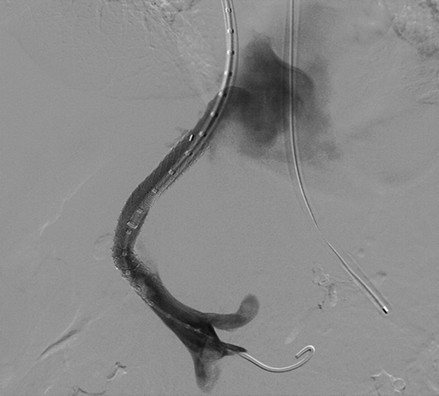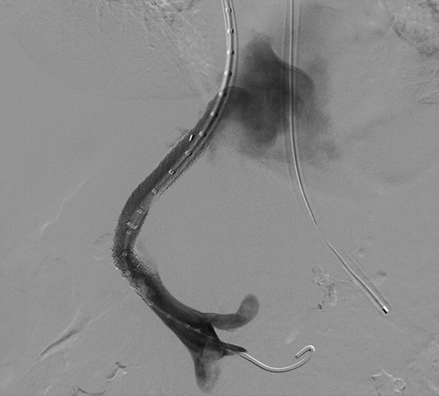78-year-old lady presented with NASH cirrhosis and refractory ascites despite medical management referred for TIPS.
A 78-year-old lady presented with NASH cirrhosis and refractory ascites despite medical management referred for TIPS.
- Initial hepatic venogram. Needle and catheter is advanced from the hepatic vein into the right portal vein.
- Initial puncture portal venogram
- Final portal venogram
- The parenchymal tract is dilated.
- End of first stent deployment.
- End of second stent deployment.
- Porto-hepatic shunt.
Discussion:
- TIPS is a percutaneous imaging-guided procedure in which a channel is constructed within the liver with the intent of reducing portal pressure by diverting blood from the portal to the systemic circulation.
- Indications: Secondary prevention of esophageal variceal bleeding – Level of evidence 1A
- Treatment of refractory ascites – Level of evidence 1A
- Refractory acute variceal bleed – Level of evidence 1B
- Portal hypertension gastropathy – Level of evidence 2B
- Hepatorenal syndrome – Level of evidence 2B
- Complications: Hepatic encephalopathy – Shunting of toxic neurotoxins directly into systemic circulation Procedure-related complications
- Model for End-stage Liver Disease (MELD) score – Higher MELD score predicts high post-TIPS mortality
- Serum creatinine, bilirubin, and international normalized ratio (INR) are used to calculate the MELD score
Dr. Rajesh V Helavar
MD, PDCC (Intervention Radiology)
Consultant Radiology,
Specialist Interventional Radiologist,
Columbia Asia Radiology Group
Dr. Akshay K
Radiology Resident
Columbia Asia Radiology Group



